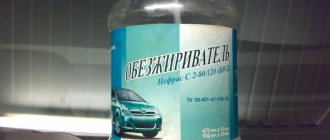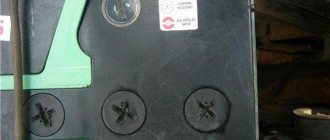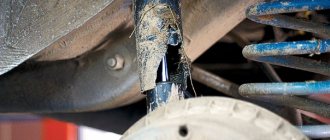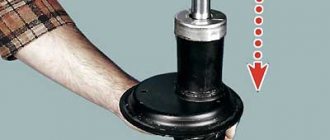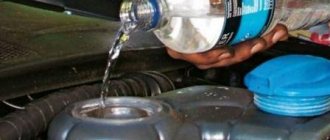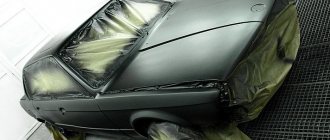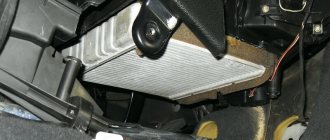When looking for cars on the secondary market, we sometimes come across offers to purchase cars at prices significantly lower than the market. Such options invariably attract attention, but such a purchase can have numerous pitfalls. The blurring of the situation is when drowned cars are sold at such a discount, which will subsequently require significant investments, and the car itself will invariably be problematic to operate. Let's talk in more detail about why such drowned cars cause problems in operation and why you should refuse to buy them.
Common breakdowns in drowned cars
Prolonged exposure to moisture not only leads to corrosion, but also damages the engine, attachments, car wiring and various electronic components. Moreover, the first to suffer is the electrics, which often fail, which leads to numerous phantom breakdowns, when the car owner has to constantly visit the service center to eliminate certain imaginary faults.
It’s worse when keeping a car in water for a long time leads to oxidation of microcircuits and automation boards. Starting such a car in the future will be problematic, and having eliminated one breakdown, you will soon need to repair other control units of the car. As a result, the car owner has to visit the service center almost every week, and repair costs will reach astronomical amounts.
Corrosion soon appears, which is extremely difficult to combat. Even those cars that have protective galvanization are covered with numerous rust bugs, which leads to the need to completely paint the car body. Moreover, even with this type of painting it is not possible to solve the problem. Within a year and a half to two years, the first problem areas will appear, which have to be repainted and eliminated. It will be easier to sell such a car than to try to restore and repaint it.
The engine also suffers seriously in cars of drowned people. First of all, this applies to situations where water has entered the working engine through the intake hole of the air filter, which leads to water hammer, which means a major overhaul of the engine and corresponding costs for restoring the machine.
How not to become a victim and not buy a drowned person instead of a good car?
Pay attention to the smell in the cabin. There should be no signs of fungus or mold. Remove the door trim and check the condition of the metal and the absence of rust, mold, etc.
d. Find out where exactly the car came from, and then try to find out whether there have been floods or other natural disasters involving water there over the past couple of months. If the car was brought by a second-hand dealer, it is better not to take risks; buy a car from an organization that has been on the market for a long time. Such an organization is unlikely to risk its reputation and deceive the buyer. In addition, if something happens to the car in the first days or weeks after purchase, you will be able to file a claim or bring specific charges. You should not buy a car with a price below the market price, do not believe in fairy tales about urgent sales and all sorts of trips abroad. Most likely there is a catch and they are trying to deceive you. If you are afraid of being deceived and buying an “underwater” car, buy a car that has never been in Europe, although this advice is more of an extreme rather than a call to action. Moreover, we have enough of our own drowned people...
If you liked the article, share it with your friends on social media. networks, this will be the best thanks to the author. Bye everyone, take care of yourselves!
Identifying a drowned car
A potential buyer of a drowned car must first study the history of the car of interest. For example, if you see that a car was imported or used by the owner in a region where there was a flood not long ago, and almost immediately after that the car was sold, then this cannot but be alarming. In this case, it is necessary to carry out the most detailed diagnostics, including with a specialist who can determine whether the car has floated or whether it has other hidden defects.
You can also find databases on insurance payments for the car you are interested in on the Internet. If you see that the car is in such a database and the payment dates coincide with the dates of the natural disaster, then, with a high degree of probability, the car you selected was floating, after which its previous owner received insurance, and the insurance company sold the car through an auction to resellers . You should refrain from purchasing a car with such problems.
conclusions
It is possible to identify the drowned person, but it is difficult, since without the original auction sheet no one can say for sure about the past of the car. The solution is to purchase the car directly from the auction, where the notes on the lot will clearly state: “sunken car.” Is such a car worth buying in principle? More likely no than yes, because problems are inevitable - many small ones or a couple of large ones - it’s a matter of time and a specific instance. But we must not forget that such transport costs almost half as much. This means that there is a certain sense in the purchase - provided that you are willing to pay for savings on corrosion and wiring glitches.
Inspecting the car
When examining a potential drowned person, you need to pay attention to the mats, bolts and door seals. Rugs are usually saturated with moisture and will have a distinct musty odor in drowning victims. It will be impossible to get rid of such a smell. New floor mats in a used car should also alert you. Why they were replaced and whether the seller is trying to hide any defects in the car.
Seat mounting bolts can also tell us whether the car has various types of problems. In cars that have been floating in water, water leaks into the interior, which invariably leads to a putrid odor, fungus and stains. To hide such troubles, sellers need to dismantle the seats and clean them using special means. And on the fastening bolts there will always be traces of seat dismantling. If you see that the seats have been removed from the car, then a reasonable question arises why.
Pay attention to the door seals. It is difficult to clear them of sand and silt, so many sellers, when preparing a drowned person, simply replace the seals with new ones. If you notice such new door seals on a used car, then this indicates a desire to hide existing defects.
nn_no_copyright
In European countries, cars that have been under water are subject to disposal, since the route to domestic markets is closed for them. What about Russian? From the experience of past years, we remember how many of them were exhibited. It is possible that swindlers will bring them in now: this source of income is too profitable for them to refuse it.
Be wary when you see in the documents of a used foreign car that it was imported from Belgium, eastern Germany, the Danube countries, including Austria, Slovakia, Poland, Romania, the Czech Republic and others, as well as from the USA - the states of Kentucky, Tennessee and Virginia (this not an exhaustive list; study the chronicle of natural disasters starting in May 2010).
From the editor: Drive-in cinema business plan
General Director Sergey Tkachev says:
— Dealers in “drowned bodies” skillfully hide the consequences of “water procedures.” But only cosmetic measures - it is not profitable for them to completely restore cars. They carry out dry cleaning of seats, upholstery, pre-sale preparation of the body, bottom - everything that can be inspected and touched.
Take a closer look at the headlights
A car's headlights can tell us whether the car was floating or had any other body problems. Drowned people will have a distinctive stripe inside their headlights that marks the water level. It is difficult to remove such an inconspicuous strip, so many sellers turn a blind eye to it. After the test drive, you should inspect the headlights, which should not sweat, which indicates a loss of tightness. In the future, such headlights will have to be replaced, and this is an extra expense for the car owner.
How to identify a sunken car during inspection
When buying a car outside of a showroom, the buyer first identifies models that might be of interest to him, and then goes to websites on the Internet to search for good deals. Unfortunately, there are many scammers in the automotive industry, and cars of poor quality are often offered at the lowest prices. These can be cars that have been in serious accidents, have been sawed up and brought into the country, and sometimes even sunk and restored.
The term “drowned” refers to cars that have fallen, for example, into a pond or river. Once a large amount of water gets into a car, it may experience problems with both driving performance and electronics. Most often, owners get rid of such cars, giving them at a low cost to people who are professionally involved in restoring “drowned cars.” After minor repairs, the car is put up for sale at a price several times higher than it was purchased from the owner, but lower (or equal) to the market price.
Buying a sunken car is extremely dangerous, since it is impossible to say for sure which parts were replaced and how well they were replaced. In addition, water does not always act immediately, and problems with the engine, suspension or electronics may begin several months after purchasing the “drowned car”. Therefore, before purchasing a car, it is important to know the main signs that indicate that the car has been sunk and restored.
Let's do a test drive
A test drive is a mandatory procedure when choosing a car. Moreover, such diagnostics on the road are best performed on a clear, sunny day on a road free of other cars. During such a test, you need to evaluate the car's performance, engine response and the absence of gearbox kicks. If the car has been in water, the engine and gearbox will invariably experience jerking. The motor will lose some power, which will not go unnoticed by a potential buyer.
Pay attention to the warning alarm. If during such a drive test any warning messages appear on the dashboard, then this may indicate problems with the electronics. You shouldn’t take the seller’s word that these are minor problems and he’ll throw off a few thousand rubles to “replace the fuse.” Such repairs can cost you tens if not hundreds of thousands of rubles, and operating the drowned car will be a real hell.
First actions after driving through a water hazard
If it happens that you have already driven through a deep ford, and now you are afraid of unpleasant consequences, it is worth having your car professionally dried. Only if moisture is quickly removed from some parts can the required quality of operation of all components of the car be achieved. Treating your car in the first 24 hours after hitting a water obstacle will help restore confidence. The set of actions is quite complex:
- it is necessary to disassemble the interior if water gets inside in order to dry it with an industrial hair dryer or heat gun for a more reliable effect of eliminating risks;
- All electrical connections that theoretically got into water are checked, disassembled and cleaned; they need to be disassembled, dried and cleaned of any deposits;
- Air filters for the engine must be replaced, as well as a cabin filter that could get wet; such filter elements will only cause a number of problems in the future;
- it is advisable to disassemble the fastenings of the boots on the CV joints and fill them with new lubricant, then seal the boots again with new clamps, this will extend their life even after a flood;
- if there is a suspicion that even a small part of the water has entered the engine, it is worth changing the oil, and at the same time replacing the spark plugs and high-voltage wires to be sure.
From the editor: Business ideas on wheels and features of their implementation
But even such a complex of works does not guarantee complete confidence that there will be no problems with the car. Drowned people often begin to rust in the most unpredictable places. If water gets into your car, it will not go unnoticed. The headlights begin to sweat, there is a damp smell in the cabin, there are certain problems with the glass sweating, and various sensors and electrical systems also fail, and contacts on the equipment fail and build.
Diagnostics with specialists
Today, many companies and private craftsmen offer an extremely popular service to help you choose a car. For several thousand rubles, such a specialist will give you a complete professional diagnostic of the car, identify existing breakdowns and be able to tell you exactly whether this car floated or whether it was really a profitable and successful purchase, which in the future will not cause you any problems in operation.
What is the danger
Most automotive experts believe that a car that has been under water for even a few minutes will not be able to function fully in the future.
Due to its high penetrating ability, water instantly gets inside hidden cavities, under the upholstery, and fills the most important components and assemblies.
At the same time, it carries with it dirt that settles on working surfaces, electrical contacts, control modules, disrupting the operation of the electronics. In situations with the engine running, the problem is aggravated by the high probability of hydraulic shock of the power unit.
To get rid of the negative consequences of immersion under water, you need to disassemble the car as much as possible and thoroughly dry all the damaged elements, replacing them if necessary. The restoration process is complex and expensive, so in most cases the owners of such cars try to urgently get rid of them in any way.
Some of them resort to fraud, hiding the fact that the car was flooded. They lower the price and try in every possible way to dissuade from large-scale diagnostics. This behavior of the seller should always be alarming.
Customer inattention and indifference
Buying a used car is always a big risk. But it is even more dangerous if the car is transported from abroad, because its fate is not thoroughly known.
Against the backdrop of recent events abroad, when floods are raging, more and more drowned cars are appearing.
It is quite logical that the previous owners wanted to get rid of such cars. But the inattention of buyers who are ready to buy a car imported from another country, without even understanding its history, is completely incomprehensible.
But drowned cars usually give themselves away right away. You just need to know their main “symptoms”.
Types of wetting. How big is the risk?
Theoretically, a jammed car is a bad thing, but in practice, not everything is so simple. Some people have been driving “mermaid cars” for many years and don’t even know it. Of course, such a car is not reliable, but cars with a clean history are also endowed with this disadvantage.
What and to what extent affects the condition of the car:
- Water.
Salty or fresh? The electrical and mechanical components of the machine fail when exposed to moisture, but its action in tandem with salt is doubly dangerous. After thorough drying, which was carried out immediately after “bathing” in fresh water, the damage is not so great. But getting rid of sea salt is much more difficult, and the destruction becomes global over time. Another important factor is the purity of the water. If it was a crystal clear mountain river, it wouldn’t be so scary. But when the interior, trunk and entire engine system become clogged with silt, clay and other debris, it is very difficult to rid the car of their invasion, and this has a doubly effect on the operation of the mechanisms. - Time spent in water.
When a car ends up in water (and even clean, unsalted water) for a few minutes, it is unlikely to suffer much damage. The main thing is to quickly and thoroughly dry it, clean it, change filters and oil. But when the car has been left flooded for several days, no amount of drying will help. The best thing to do in this situation is to claim insurance and/or scrap it. But many people prefer a more profitable option - selling the car at the maximum price before it completely breaks down. And only a few admit to the buyer the “wet” past of the product. Most prefer to hide the truth, hoping to sell the goods at an average price. - Soaking level.
Under natural conditions, the car may get wet (deep puddle, pouring rain, attempt to cross a river). It is possible to discern such a car only by carefully examining the engine compartment. But cars that have sunk headlong often go on sale. Therefore, you should be careful when choosing an iron friend after severe floods, tsunamis and other disasters.
What to do with the engine?
Basically, flooding a car with water does not happen without liquid getting into the engine. Moisture is extremely dangerous for the engine, so starting it with the understanding that the car has been in water is not recommended. Liquid enters the engine through the oil plug and throttle body. Restoration work on the engine after the car gets into water should be reduced to the following procedures:
- Dismantle the cylinder head.
- Let the parts dry.
- Replace the piston rings.
- Drain the oil from the system.
- Remove and clean the throttle.
- Replace oil and air filters.
After all of the above, it is necessary to test the spark plugs and ignition coils for serviceability. If there are any problems with them, they should also be replaced with new ones.
The video will talk about restoring a sunken car: Published: February 26, 2020
